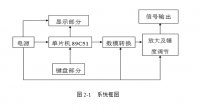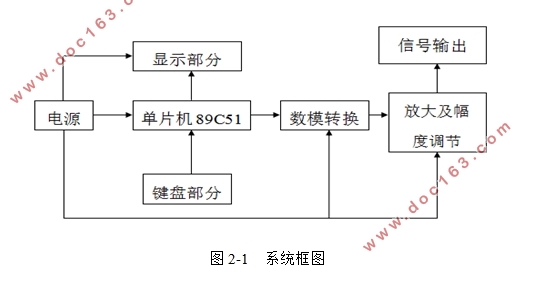基于单片机AT89C51的信号发生器设计

基于单片机AT89C51的信号发生器设计(任务书,开题报告,论文14500字)
摘 要
信号发生器是人们工作学习中经常使用的,是信号产生的源头,在教学科研、学术研究等方面有着非常多的应用。平常使用的信号发生器不仅输出的波形种类比较少,价格昂贵,而且硬件很复杂,频率非常的低,只能在相对狭窄的范围内应用,不能满足使用者的实际需要。而信号发生器开发后,可以非常方便的、非常容易的输入波形。它是可以用一些数组值来将数据存储到里面,最终产生需要的波形。
本设计使用的主要器件为AT89C51,然后经过DAC0832将输出的数字信号转换成模拟信号,因为数模转换器是以电流形式输出的,所以还需要外接放大电路,将电流转化为电压的形式输出,最后通过LCD显示出对应的波形的名称和频率。通过程序的编写可仿真出锯齿波、方波、正弦波、三角波,并能通过按键的输入改变波的频率,,达到人机交互的目的。其设计性能稳定、价格低、具有很高的实用性。
关键词:单片机 D/A转换 信号发生器
Signal generator design based on single chip microcomputer
Abstract
Signal generator is frequently used in our work and study, what Is the signal source, It has a lot of applications in teaching and research, academic research, etc. Common use of signal generator output waveforms not only species is relatively small, expensive,and the hardware is very complex,frequency is very low, it can only be used within a relatively narrow range,so it can not meet our actual needs.The development of the signal generator, can be very convenient, very easy to input waveform. It is possible to use some array value to store data into it, and ultimately generate waveforms needed.
The main components of this design is AT89C51, then through the DAC0832 digital signal into an analog output,Because the DAC is a current output in the form of, so it needs an external amplifier circuit, the current into a voltage output form.In the end, display the corresponding name and frequency of the waveform through the LCD.It can simulation the sawtooth wave and square wave, sine wave, triangular wave through the writing of the program. And can be changed through the pressed key input wave frequency and shape, so it achieve the purpose of human-computer interaction. Its design is stable,with low price and with high availability.
Key Words: Single chip microcomputer; D/A conversion; Signal generator
[版权所有:http://DOC163.com]

目 录
摘 要 I
Abstract II
第一章 绪论 1
1.1 信号发生器的发展现状 1
1.2研究信号发生器的背景及意义 1
1.3论文章节安排 2
第二章 系统设计 3
2.1 系统原理框图 3
2.2设计原理 3
2.3系统方案及模块选择 4
2.3.1系统方案的对比及选择 4
2.3.2系统主要模块的选择 5
2.4 本章小结 6
第三章 硬件电路的设计 7
3.1 单片机的介绍及应用 7
3.1.1 单片机的背景简介 7
3.1.2单片机系统 7
[版权所有:http://DOC163.com]
3.1.3单片机在信号发生器中的应用 9
3.2各部分电路设计 10
3.2.1数/模转换电路设计 10
3.2.2按键接口电路 12
3.2.3液晶显示电路设计 14
3.3 本章小结 15
第四章 软件设计 16
4.1系统软件设计 16
4.1.1 编程语言种类 16
4.1.2单片机软件开发系统 16
4.2软件流程图 17
4.2.1系统软件流程图 17
4.2.2按键输入的流程图 18
4.3 波形的产生 18
4.3.1正弦波的产生 18
4.3.2三角波的产生 19
4.3.3锯齿波的产生 20
4.3.4方波的产生 20
4.4 本章小结 21
第五章 实验结果与分析 22
5.1软件介绍与联调 22
5.2仿真结果及分析 22 [来源:http://Doc163.com]
5.3 本章小结 29
结 论 30
参考文献 31
致 谢 33 [资料来源:www.doc163.com]
